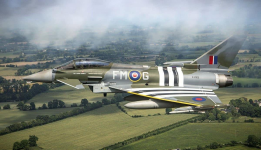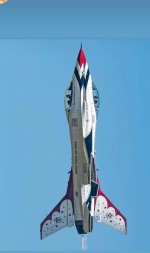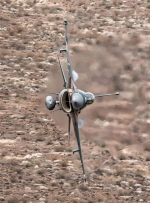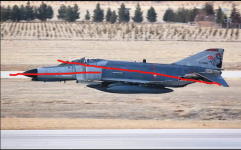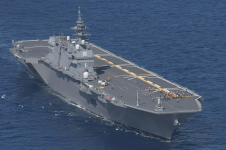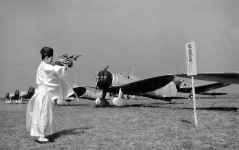Navigation
Install the app
How to install the app on iOS
Follow along with the video below to see how to install our site as a web app on your home screen.
Note: This feature may not be available in some browsers.
More options
Style variation
You are using an out of date browser. It may not display this or other websites correctly.
You should upgrade or use an alternative browser.
You should upgrade or use an alternative browser.
The Ultimate Military Combat Aircraft & All Others Thread (All Topics).
- Thread starter GoMig-21
- Start date
GoMig-21
Elite Member
- Oct 16, 2016
- 9,269
- 14,353
- Country of Origin

- Country of Residence

- Thread starter
- #53
This Austrian Airlines A320 was severely damaged by a hailstorm while on approach to Vienna Airport in Austria. While the benefit of softer composites for the radome is beneficial for the beaming of the radar's electromagnetic waves, it does have a disadvantage in cases of bird strikes and hail storms.
The cap and the hard glass were severely damaged, but the body seems untouched! Incredible.
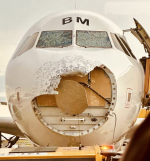
The cap and the hard glass were severely damaged, but the body seems untouched! Incredible.

Fatman17
THINK TANK: CONSULTANT
- Apr 24, 2007
- 37,450
- 43,825
- Country of Origin

- Country of Residence

ENGLISH ELECTRIC LIGHTING VS MIG-21 AND F-104: COLD WAR WARRIORS COMPARED
- Aviation Features
- English Electric Lighting vs MiG-21 and F-104: Cold War Warriors compared
13th October 2022
FEATURE
How did the Lightning compare with other fast jets in service at the time? The July 2014 issue of FlyPast provided this comparison
By the 1960s, the race was on to develop ever faster and more potent jet fighters. The perceived threats during the ‘Cold War’ meant that interceptors had to be fast enough to catch the increasingly powerful bombers and high-flying reconnaissance aircraft of potential opponents.
The English Electric Lightning, famously described by one pilot as ‘like being saddled to a skyrocket’, was immensely powerful, stacking together two Rolls-Royce Avon turbojets within the fuselage in order to attain speeds in excess of Mach 2. The price for this speed was a lack of range, which was addressed in later variants by the addition of increased fuel capacity and/or overwing fuel tanks. Rarely used in anger, the Lightning nevertheless posed a significant deterrent, and could be scrambled rapidly from appropriately named Quick Reaction Alert ‘sheds’.
Another ‘winged rocket’, the Lockheed F-104 Starfighter, could match and even exceed the top speed of the Lightning, but was initially let down by a poor safety record. With modifications, the type soldiered on until 2004 in the hands of the Italian Air Force, long after the Lightning had been retired from military use.
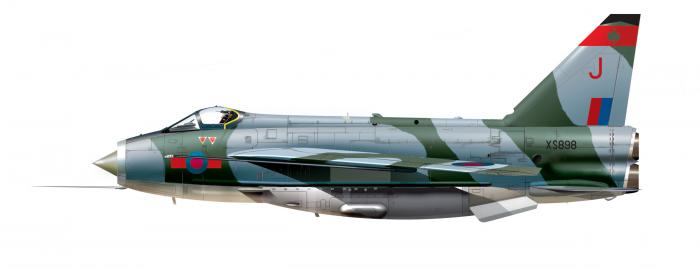
The British aircraft’s most likely opponent, the Mikoyan-Gurevich MiG-21 Fishbed, was an exceptional machine, and an ideal platform for development. With well over 10,000 built (compared to fewer than 400 Lightnings), the delta-winged fighter was remarkably quick given its relatively small engine. The Sukhoi Su-7 was another Russian-built aircraft that pleased pilots with its rapid speed and docile handling characteristics. On the downside, it had only a small combat radius and required long runways to operate from.
The McDonnell Douglas F-4 Phantom II eventually came to serve as the primary air superiority fighter for both the USAF and the US Navy, and with good reason. Though not quite as fast as either the Lightning or Starfighter, it was versatile and very well armed. Over Vietnam, US Phantoms proved they were better than enemy MiG-17 and MiG-21 fighters, and its success can also be seen in the numbers of nations that operated it, among them the United Kingdom.

English Electric Lightning F.6
Construction: A total of 337 Lightnings were built, including 62 F.6 variants.First Flight: The P.1 prototype WB760 first flew on August 4, 1954, in the hands of Roland Beamont.
Powerplant: Two 13,220lb (58.8kN) dry/16,300lb with afterburner Rolls-Royce Avon 301/302 turbojets.
Dimension: Span 34ft 10in (10.62m). Length 55ft 3in. Height 19ft 7in. Wing area 474sq ft (44.0m2).
Weight: Empty 31,000lb (14,062kg). Normal loaded 39,940lb. Maximum take-off weight 41,700lb.
Performance: Max speed 1,350mph (2,275km/h) at 36,000ft (10,973m). Max climb 50,000ft per minute. Service ceiling 57,000ft. Range 850 miles (1,370km) or 1,270 miles with ferry tanks.
Armament: Two 30mm cannon in forward ventral pack and provision to carry combinations of two Firestreak or Red Top missiles.
Crew: One.
Note: performance and weights varied according to role and configuration.



Lockheed F-104G Starfighter
Construction: Of the 2,422 Starfighters built, 1,122 were ’G models.First Flight: The prototype made its first flight on March 4, 1954.
Powerplant: One 10,000lb (44.5kN) dry/15,600lb with afterburner General Electric J79-GE-11A turbojet.
Dimension: Span 21ft 11in (6.68m). Length 54ft 9in. Height 13ft 6in. Wing area 196sq ft (18.2m2).
Weight: Empty 13,966lb (6,335kg). Maximum take-off weight 29,034lb.
Performance: Max speed 1,450mph (2,334km/h) at 36,000ft (10,973m). Max climb 55,000ft per minute. Service ceiling 58,000ft. Range 774 miles (1,246km).
Armament: One 20mm six-barrel rotary cannon in lower forward fuselage, plus two wingtip, one fuselage and four underwing hardpoints for max 4,000lb (1,814kg) air-to-air or air-to-ground ordnance.
Crew: One.
Fatman17
THINK TANK: CONSULTANT
- Apr 24, 2007
- 37,450
- 43,825
- Country of Origin

- Country of Residence

Note: performance and weights varied according to role and configuration


 Mikoyan-Gurevich MiG-21bis ‘MIG-130’ of the Finnish Air Force, based at Kuopio-Rissala, 1980. PETE WEST-2014
Mikoyan-Gurevich MiG-21bis ‘MIG-130’ of the Finnish Air Force, based at Kuopio-Rissala, 1980. PETE WEST-2014
First Flight: The swept wing Ye-2 first flew on February 14, 1955, with the delta-configured Ye-4 flying on June 16.
Powerplant: One 9,039lb (40.2kN) dry/15,652lb with afterburner Tumansky R-25-300 turbojet.
Dimension: Span 23ft 6in (7.15m). Length 48ft 3in. Height 13ft 6in. Wing area 248sq ft (23.0m2).
Weight: Empty 12,881lb (5,843kg). Normal loaded 19,180lb. Maximum take-off weight 23,082lb.
Performance: Max speed 1,353mph (2,178km/h) at 42,600ft (12,984m). Max climb 45,275ft per minute. Service ceiling 57,400ft. Range 690 miles (1,110km) or 1,180 miles with drop tanks.
Armament: One 23mm twin barrel cannon in ventral pack, one centreline and four underwing hardpoints for max 4,409lb (2,000kg) ordnance including AA-2 Atoll or AA-8 Aphid air-to-air missiles, bombs and rocket pods.
Crew: One.
Note: performance and weights varied according to role and configuration.





Mikoyan-Gurevich MiG-21bis
Construction: A total of 10,158 MiG-21s of all versions were built in the USSR, plus 651 in India and 195 in Czechoslovakia.First Flight: The swept wing Ye-2 first flew on February 14, 1955, with the delta-configured Ye-4 flying on June 16.
Powerplant: One 9,039lb (40.2kN) dry/15,652lb with afterburner Tumansky R-25-300 turbojet.
Dimension: Span 23ft 6in (7.15m). Length 48ft 3in. Height 13ft 6in. Wing area 248sq ft (23.0m2).
Weight: Empty 12,881lb (5,843kg). Normal loaded 19,180lb. Maximum take-off weight 23,082lb.
Performance: Max speed 1,353mph (2,178km/h) at 42,600ft (12,984m). Max climb 45,275ft per minute. Service ceiling 57,400ft. Range 690 miles (1,110km) or 1,180 miles with drop tanks.
Armament: One 23mm twin barrel cannon in ventral pack, one centreline and four underwing hardpoints for max 4,409lb (2,000kg) ordnance including AA-2 Atoll or AA-8 Aphid air-to-air missiles, bombs and rocket pods.
Crew: One.
Note: performance and weights varied according to role and configuration.

Topics
Read more about
Originally published in FlyPast Magazine
MastanKhan
THINK TANK: CONSULTANT
- Dec 26, 2005
- 21,924
- 59,698
- Country of Origin

- Country of Residence

Hi,@MastanKhan , remember we were talking about this on the old PDF? The necessity of flexibility in some aircraft's wings and the extent of it.
In this graph of the B-52's wing flexing range, at a span of 185ft (56.3m) it can be as much as 26 feet, or just under 8 meters!
View attachment 46931
One time flying in an air bus 380---at park position I marked the wing tip position on the window---then saw the difference at 38000 feet.
I don't recall the exact numbers I wrote in that post but my rough estimate was about 15-17 ft rise in the position of the wing tip from the mark on the window---.
So---up and down variation on the A380 be over 20 feet.
AmirIGM
Senior Member
- Dec 13, 2015
- 4,224
- 8,752
- Country of Origin

- Country of Residence

I didn't know there would be fines if it was overweight, but I did know that the F-14 was basically the replacement for the failed F-111B. In fact the F-14 traces a lot of its subsystems to the F-111B, including the TF-30 engines in the F-14A (meant to be interim, but unfortunately only very few F-14B/Ds with the F-110 engines were built), the AWG-9, and the AIM-54.According to combat aircraft encyclopedia, the failure of the General Dynamics F-111B to meet U.S. Navy requirements for an advanced carrier-based air-superiority fighter led to a new design contest, which was won by Grumman with its variable-geometry, two-seat, twin-engine aircraft. Designated the F-14 and named Tomcat, first flight occurred in December 1970.
However, for the development of the F-14 to be successful, it had to deal with considerable challenges was granted, mostly clauses set by the US government and the Pentagon. Those challenges conditions it had to meet or it would be fined, amongst other things, with the following parameters:
- $440,000 for every 100lbs that new aircraft was overweight
- $1.056 million for each knot over requested approach speed
- and $5,000 for every day it was late in delivering the first prototype.
View attachment 47106
@AmirIGM did you know this?
Also, IIRC, it was the first fighter designated in the teens.
Considering its F-111B components, Grumman did an amazing job to make the F-14 such an excellent fighter. Contrary to popular belief it was a very capable dogfighter and could match if not beat the F-15 which had a much less powerful radar-missile combo. I've also read that despite the complexity of the variable geometry wings, they provide such an aerodynamic advantage that to get a fixed-wing aircraft of the F-14's capabilities (weight, speed, payload) to fly slow enough to land on a carrier the design would be 1-2 tons heavier! Grumman made a model which showed it would need a bigger, heavier wing.
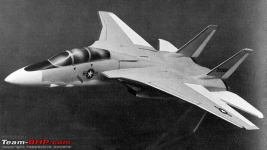
panzerfaust 3
SpeedLimited
- Mar 6, 2024
- 264
- 166
- Country of Origin

- Country of Residence

I read about it!The twin P-51 Mustang was actually a thing that was successful, as an operational aircraft but obviously went nowhere.
View attachment 46780
My question is who's controlling the plane?
panzerfaust 3
SpeedLimited
- Mar 6, 2024
- 264
- 166
- Country of Origin

- Country of Residence

My love !!
It could be the prettiest plane
Users who are viewing this thread
Total: 1 (members: 0, guests: 1)
Pakistan Defence Latest
-
-
Azerbaijan Air Force Becomes Fourth Operator of JF-17 Fighter Aircraft, President Aliyev Confirms (12 Viewers)
- Latest: Hakikat ve Hikmet
-
-
Pak-Afghan Border Skirmishes and Terrorism Watch
- Latest: Asfandyar Bhittani
-
Country Watch Latest
-
-
-
PTC Industries of India Secures Major BAE Systems Deal for M777 Howitzer Titanium Castings (2 Viewers)
- Latest: DDG-80
-
-
Latest Posts
-
Chinese Type 041 Zhou class mini nuclear submarine reported to have sunk in Wuhan (9 Viewers)
- Latest: ety
-
-
Hezbollah-Israel Conflict 2024 - Lebanon & Occupied Palestine Territories (42 Viewers)
- Latest: Persian Gulf
-
Maulana Tauqeer : if 1% Muslims reach Delhi, Modi will have to flee" (15 Viewers)
- Latest: lightoftruth


